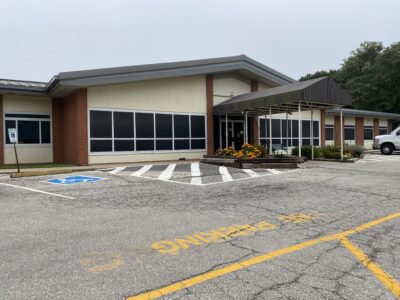$1M in ARPA funding will help Housing Stabilization Collaborative to continue providing rent and utility assistance

photo by: Austin Hornbostel/Journal-World
The Douglas County Human Services Building, 2518 Ridge Court, is pictured Tuesday, Sept. 6, 2022.
When the dust had settled on Douglas County leaders’ work to allocate more than $20 million in American Rescue Plan Act funding, Douglas County’s Housing Stabilization Collaborative was one of the beneficiaries.
The collaborative works with a group of 12 partnering local service agencies and also facilitates rent and utility assistance and landlord best-practices programs and a monthly rental availability list. The HSC was one of four agencies geared toward housing assistance selected to receive ARPA funding, representing a significant county investment in local housing initiatives. Those agencies combined to receive more than $8 million in ARPA aid.
The HSC’s initial request was for more than $2 million, but the amount Douglas County leaders approved was pared down to $1 million. Gabi Sprague, Douglas County’s human services program manager and the facilitator of the HSC’s stabilization program, said $850,000 of that money would go toward rent and utility assistance. The remaining $150,000 will go toward supportive service stipends paid out to partnering agencies who process and follow up with applicants to provide additional access to resources.
Since the beginning of July, the HSC has already used about $270,000 of its ARPA funding, Sprague told the Journal-World Tuesday. That money has gone to more than 370 households, for an average payment of $726 per household. Much of it is utility assistance, helping to keep tenants from having their water, gas or electricity shut off, or rent assistance preventing eviction or allowing households to spread their money toward other needed expenses.
The HSC uses such funding, like ARPA aid or the roughly $225,000 loosely planned for through the county’s annual budget process, in tandem with aid from the Kansas Emergency Rental Assistance program, administered by the nonprofit Kansas Housing Resources Corporation. Since March of 2020, Sprague said Douglas County has gotten about $8 million from that program. It’s funded through the federal Coronavirus Response and Relief Supplemental Appropriations Act of 2021 and ARPA.
But that means the program will likely end by the end of the year, Sprague said.
“If you want to talk about need, it’s going to be hard,” Sprague said. “We’ve developed, through federal funds that made all these emergency rental assistance programs, sort of systems of support that are just going away due to the federal government not allocating resources to that.”
Luckily, Sprague said, she thinks Douglas County is situated pretty well to weather that loss. On top of its remaining ARPA aid and the aforementioned dollars allocated through the county budget, Sprague said the HSC can also count on another $100,000 in alignment with what the county was already allocating toward rent and utility assistance prior to the pandemic. The grand total will be divided and spread over the course of the next 16 months, a period which Sprague said would likely be pretty rough for folks as aid programs like Kansas Emergency Rental Assistance end.
That’ll be an adjustment. Since April of 2021, Sprague said assistance on this level has been pretty “unbridled.” Now, she said there will be a need to set a monthly limit on assistance in what has already been a time of enormous need.
By extension, it means that for the clients there isn’t the capacity to help — utility shutoffs become a looming threat to housing security.
“I think we’re in a housing crisis and we only have so much money to spend, and the households that don’t receive assistance will be at increased risk of homelessness,” Sprague said.
Agencies are doing what they can, Sprague said, but they’re hampered by how much the federal government is allocating to help support households at a local level.
It’s an issue that isn’t unique to Douglas County, she said, but rather occurring nationally amid a housing shortage and the slowing pipeline of federal aid. Moving the needle will take a number of actions, some of which Sprague said are already happening locally. For one, agencies in the county like HSC partnering agency Tenants to Homeowners have been putting their money toward developing permanent supportive housing, but that takes a long time to build.
Systemic solutions could also help, such as adopting a local tenants’ right to counsel, a topic Sprague has spoken with the Journal-World about before. In a nutshell, that would guarantee tenants facing eviction the right to legal representation in a similar manner as in criminal trials, and she said it could serve as a way for tenants to pursue legal recourse more easily. Sprague said the HSC is currently looking for funding to start a pilot program that could provide some evidence that a permanent program could be effective locally.
Sprague noted that there are some good signs for renters in Douglas County. One of them was highlighted in a report prepared by the Kansas Supreme Court’s ad hoc committee on best practices for eviction proceedings earlier this year. Sprague said the report notes that Douglas County’s 7th Judicial District has a higher number of eviction petitions dismissed, or sorted out between landlord and tenant outside of a trial — about 34%, significantly higher than the 25% average across the state.
“I don’t know for sure, it could be for a lot of different reasons, but I would like to think that some amount of the work that the HSC has done and all the partnering organizations have done has contributed to that,” Sprague said. “And I know that we’ve worked with quite a few people who are actively getting evicted and we’re able to tell the landlord, ‘Hey, we can pay this off if you stop,’ and it’s worked out.”







